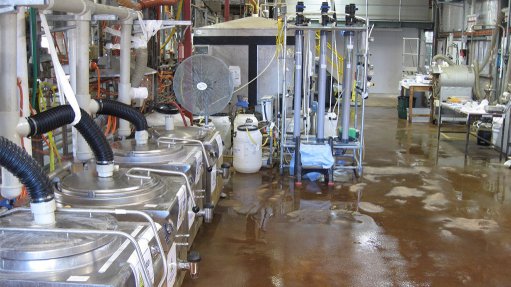
Lithium Australia pilot plant
JOHANNESBURG (miningweekly.com) – ASX-listed Lithium Australia will build a large-scale pilot plant to recover lithium chemicals from micas in industrial waste streams using its SiLeach technology, the company said in a statement on Thursday.
“Lithium Australia now has sufficient confidence in its SiLeach technology to commit to developing a large-scale pilot plant (LSPP), has approved the front-end engineering and design (FEED) and will procure long-lead equipment in an effort to reduce the time frame through to commissioning and production, currently scheduled for early 2021,” said Lithium Australia MD Adrian Griffin.
Within the current quarter, the company expected to secure an LSPP site, infrastructure (power, water, gas, road and rail), and major reagent supplies and process feed material.
Further financial details will be released on completion of the FEED, while details of infrastructure and supply contracts will be released as they become available, Griffin said.
“Constructing and operating the LSPP is considered a necessary step in the commercialisation of SiLeach, and will integrate data collected on an industrial scale to inform the next step, which is full commercial production,” he explained.
The LSPP is designed to produce lithium carbonate equivalent (LCE) at a rate of 2 500 t/y from about 27 500 t of lepidolite mica feed (to a maximum grade of 4.5% lithium oxide). This output is about one-tenth the output of a full-scale commercial lithium carbonate production facility.
However, actual output will depend on the final feed grades achieved from a particular source, and the likelihood is that the locally sourced feed will be of a lower grade and produce less output than the 2 500-t design capacity, added Griffin.
While the primary aim of the LSPP is to produce lithium chemicals, production of by-products is also integral to its development. Potentially, by-products like potassium sulphate, sodium silicate, caesium and rubidium can also be produced using the SiLeach process.
“Success will allow us to use mine waste in the production of lithium chemicals, which is one of our great sustainability goals.”
Lithium Australia completed a prefeasibility study (PFS) on the application of its SiLeach technology to recover lithium chemicals in July 2017.
The PFS identified the water balance as a critical area for consideration. Process steps were developed to improve the water balance, as well as processes that capitalise on the co-production of potassium sulphate, which improves financial performance.
“Capital cost reductions in downstream unit processes have been achieved by the breakthrough in water management. The target feed material during the first year of the LSPP's operation will be primary ore mined close to the proposed location of the plant, so crushing, grinding and concentration circuits will be required at the feed end of the plant, an additional equipment cost.”
Lithium Australia has been involved in the research and development of chemical processing technology for the economic recovery of lithium from spodumene and lepidolite minerals since 2014.
This led to the development of the SiLeach process, a fluoride-accelerated sulphuric-acid leach at elevated temperature, but atmospheric pressure.
Large quantities of lithium continue to be discharged to waste streams from the production of a range of industrial minerals. Such waste streams, which most commonly contain lithium micas, may prove the most cost-effective source of primary lithium.
Commercialisation of the SiLeach process will allow for exploitation of this waste.